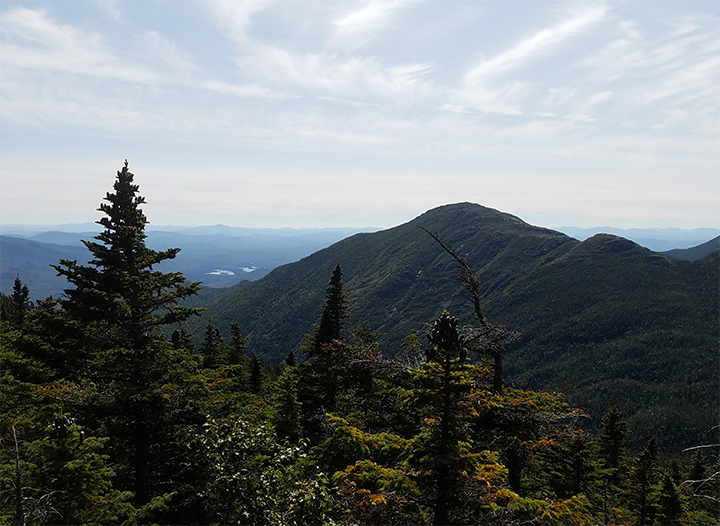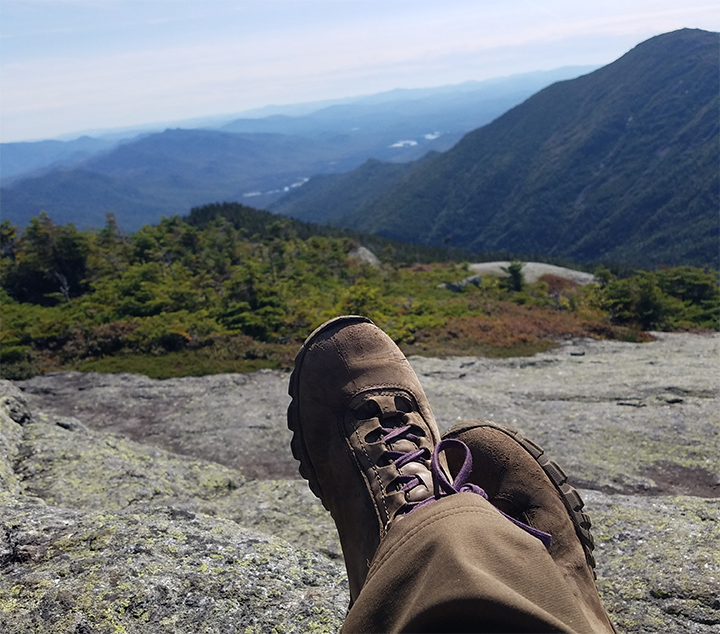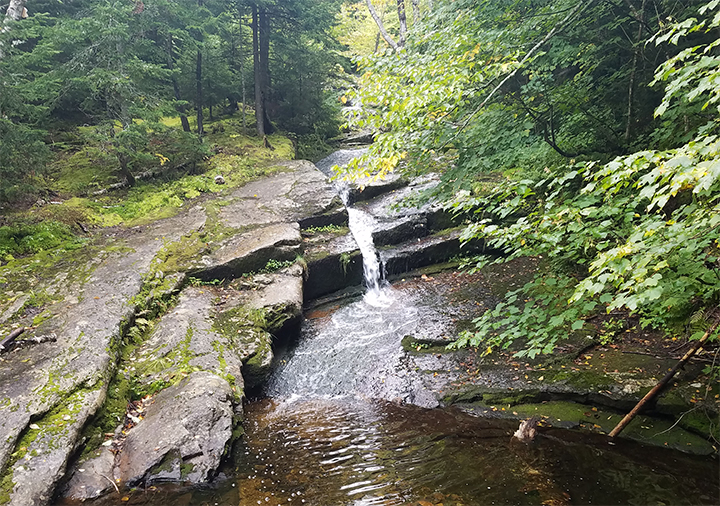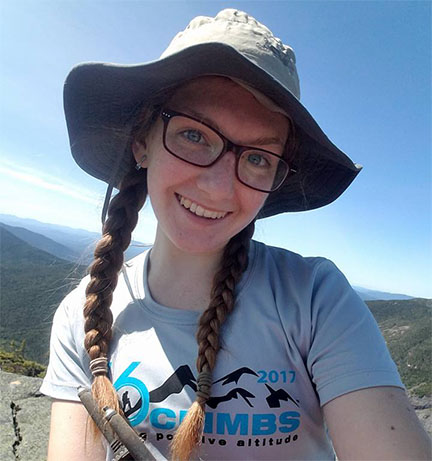
Why I’m Part of the Problem Too | Personal Goals vs. Stewardship Responsibility
Friday, August 17, 2018
By: Meg Desmond - Adirondack Council Clarence Petty Intern
Personal Goals in the Backcountry
Every year, millions of people are drawn to the outdoors for a multitude of reasons. Everyone has their own motivation and for many, a large part of it is the physical challenge that the outdoors provide. In nature’s playground, we can set attainable goals for ourselves and see tangible progress in achieving them. Whether the goals are short term, beginning the day with an aim to summit, to avoid sunburn, to hike faster, to fall less, or long term, and include training for through hikes or hiking specific groupings of mountains, these pointed objectives encourage people to get outside and push themselves. Further, achieving short term goals, and marking progress with long term ones, establishes a powerful feeling of pride and accomplishment that drives the goal-setting cycle.
In the Adirondacks, the most popular goal is to hike all 46 High Peaks; High Peaks being mountains that are at least 4000 ft. tall. There are currently over 10,000 official registered 46ers. I know several of these individuals, and like myself, others are aspiring to join the ranks.
In speaking with a recent 46er, he commented that he needed a new challenge to encourage himself to continue to get out and explore. Working towards 46 kept him going out on those days when motivation was low, and improved his time management, freeing up weekends and giving him the focus and determination to get into the mountains.
 View from Saddleback
View from Saddleback
The Externalities of Success
Focus and determination are admirable qualities. It is valuable to be driven and goal oriented, especially with physical tasks. The 46 High Peaks are an excellent example of a specific and attainable goal that can be achieved one step, or peak, at a time. Truly, any hike can serve to create a tangible objective. However, when the success of a personal goal is confronted with a potential negative impact on natural resources, we must consider the consequences of our actions.
When an obstacle stands between myself and my planned peak, I will do what it takes to overcome the challenge. This drive to persevere is commendable until it means parking dangerously at an already overcrowded trail head, or abandoning the trail to bushwhack, or sneaking in a hike during mud season because what harm can one person really do, right?
Wrong.
The Leave No Trace Principles (LNT) were established to dictate behavior in the backcountry. They call on us to...
- Plan ahead and prepare
- Travel and camp on durable surfaces
- Dispose of waste properly
- Leave what you find
- Minimize campfire impact
- Respect wildlife
- Be considerate of other visitors
While it may not appear to be harmful when you break one of these principles, the impact on the ecosystem effects not only the land but the future enjoyment of others.

If parking at a trailhead is dangerously full, consider seeking an alternate trail rather than creating spaces on the edges of shoulders or precarious embankments. While exploring off trail can be exciting, it’s incredibly important to recognize the impacts of trampling vegetation and the increased risk of spreading invasive species.
I’ve often found myself standing at these crossroads, arms folded and frowning, the picture of a petulant child under the guise of a committed outdoorswoman. These “inconveniences” are not obstacles to be overcome or challenges to conquer.
Instead, these opportunities for humility call us to remember why we originally decided to step out on the trail. I have always found the outdoors to serve as a respite, an escape from the expectations, social pressures and general hectic rush of daily life. Being outside is a time to slow down. Yet, I bring these constructs, this fast paced energy with me, when I make decisions to place my personal goals before my stewardship responsibilities.
Experience Does Not Equal Entitlement
Even experience and knowledge cannot always outweigh apathy. At times I’ve found that my awareness of issues gives me the illusion that I am above them. Clearly experienced hikers aren’t the problem right? I know all seven Leave No Trace Principles. I understand hiker etiquette. I walk through and not around mud. Doesn’t this entitle me to the land I recreate in? I shouldn’t have to change my plans or alter my routes.
Regardless of the amount of time we spend in a space, that doesn’t make it ours to claim. Your personal connection with land is just that, personal. And while this attachment to and love for an area is a beautiful demonstration of the importance and depth of nature, it should encourage us to steward the land rather than judge those with less experience who come to visit.

Creating a Personal Ethic
I have seen experienced hikers cut corners and make questionable decisions, and I have been that experienced hiker as well. We are all flawed and it’s easy to let a convenient solution take the place of an appropriate one.
Even the language we use can begin to distort our stewardship perspectives. When did we begin to “conquer” peaks like settlers grabbing at land and staking claim? We share this valuable resource with local communities and visitors alike. We all have the opportunity to serve as caretakers for this space. This space that is intended to remain Forever Wild. This space where we have the privilege to recreate; to walk its trails, climb its rocks and paddle its waters.
Above a high peak or a through hike, let’s make stewardship our most important backcountry goal. Let us reflect on our own decisions and educate others, leading with both our words and actions so that we all may continue to recreate in a beautiful and wild space. Let us make goals to pick up all trash we see on trail, to keep safety a priority in the parking lot as well as in the mountains, and to adhere to the LNT principles. Let us steward the places that inspire us, allowing future generations to experience their wonder as well.
What You Can Do
Being a steward may seem like a grand responsibility and commitment, but it can be as simple as being an intentional and conscientious hiker. Learning the seven principles of LNT is the first step in becoming a more knowledgeable steward. All healthy backcountry practices fall under one of the seven principles. A few highlights include...
- Plan ahead and prepare: In addition to packing food, water, and appropriate clothing, create a “Plan B” for your day and explore some of the Department of Environmental Conservation's alternative hike suggestions.
- Travel and camp on durable surfaces: Trail-widening and trampled vegetation have become issues due to an increase in hikers. Much of this is caused by people trying to avoid mud and other obstacles. When trails are muddy, walk through, not around the mud.
- Dispose of waste properly: With an increased number of people utilizing the trails, it is even more critical to pack out everything you carry in and learn to dig proper cat holes.
- Be considerate of other visitors: Overcrowded parking lots and parking on narrow shoulders can cause traffic accidents and put people at risk. If a trailhead is already full, seek an alternative adventure using the plan you created.
|





